With the batteries chosen, thoughts must now turn to charging them. We will be having a generator and of course shore power when in a marina, but one of the most popular, “modern” ways of charging batteries on the canal is using the power of the sun.
I say modern, as when we were last regularly cruising (about 14-15 years ago) solar panels on boats were in their infancy and it was a novelty to see one or two panels on the roof of a narrow boat. Now they are a common sight and I found that I needed to quickly understand the technology, so that I could make an informed decision on what solar panels we would have on “Old Nick”.
A solar panel or “Photovoltaic Panel” (PV Panel) to give its scientific name, is basically a series of cells which contain layers of silicon, phosphorous and boron. When the sun’s energy falls on the cells, they convert it to electrical energy by the “photovoltaic effect”.
The amount of electrical energy produced, depends on the number of cells in the solar panel, the efficiency and position of the panel and of course the amount and strength of sunlight that falls on the panel during the day. Midday sunlight that hits the panel at 90 degs will be converted more efficiently than early morning or late afternoon sunlight where the sun is lower in the sky and of course clouds and shadowing will also reduce the amount of energy converted.
If you have a look at the two graphs below, kindly provided by Phil Brook-Little (administrator of the Facebook 12 Volt Boating Group), you will see that over the course of a day, a solar panel’s voltage will jump up quite quickly when the sun first comes out (at about 5.18 am in lower graph), but the all important current does not really start to kick-in until after 7am and even by 8am it is still only at half its full level. Note that by 11am the batteries are topped up and the controller drops the current off, which is why you see the voltage rise again.
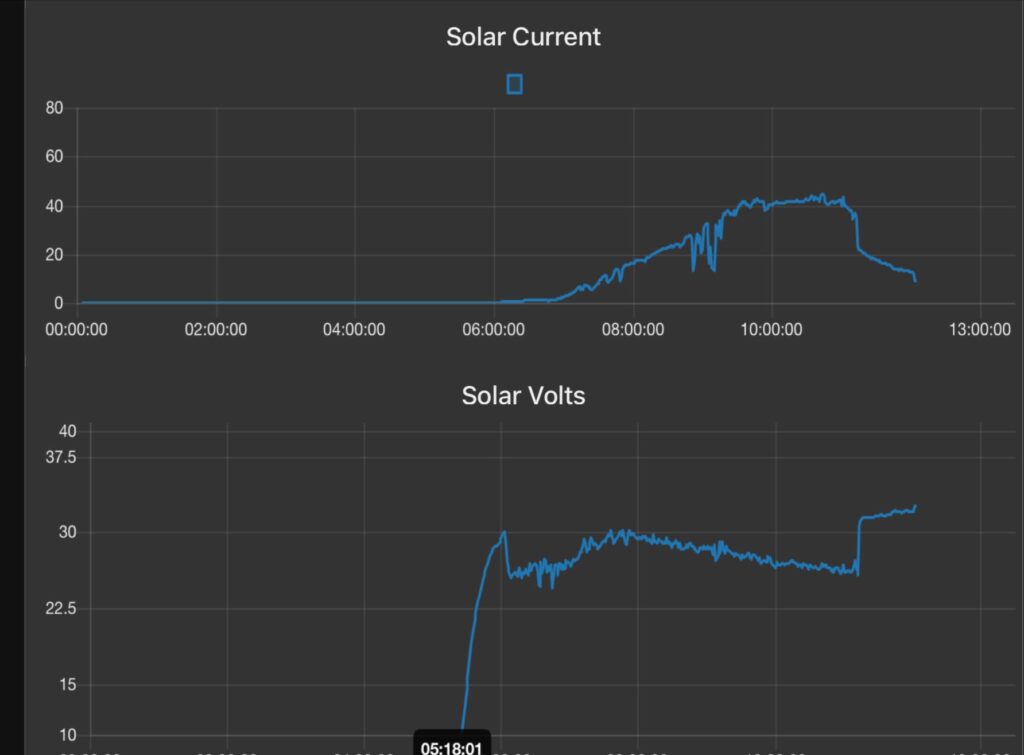
When you are choosing a solar panel, aside from the the physical size, type of mounting, etc. the key electrical specifications are:
- Power Output in Watts
- Maximum Power Voltage in Volts
- Maximum Power Current in Amps
The more panels you have the more power (Watts) you can put in to the battery to recharge it. When you are reliant on your batteries for propulsion, cooking and all of the other things in life that we take for granted, you are going to use a lot of power, so we have decided to give up as much of the roof space as possible to solar panels.
In order to charge the batteries, the voltage that the panels produce has to be higher than the nominal battery voltage – which on “Old Nick” is 48v. Most popular solar panels are designed for 12v systems and so we will need to combine multiple solar panels in series to create a higher voltage – just like stacking a set of 1.5v AA batteries together to create 3v, 6v, 9v, etc.
The panels that Ortomarine fit as standard are supplied by Photonic Universe and generate around 20v per panel. They usually fit them in groups of 4 panels in series giving 80v of total output voltage. On “Old Nick” we have enough roof space for two groups of 4 panels but unfortunately not enough for three groups of 4 panels, as they recently fitted on “Hunky Dory” which is a longer boat.
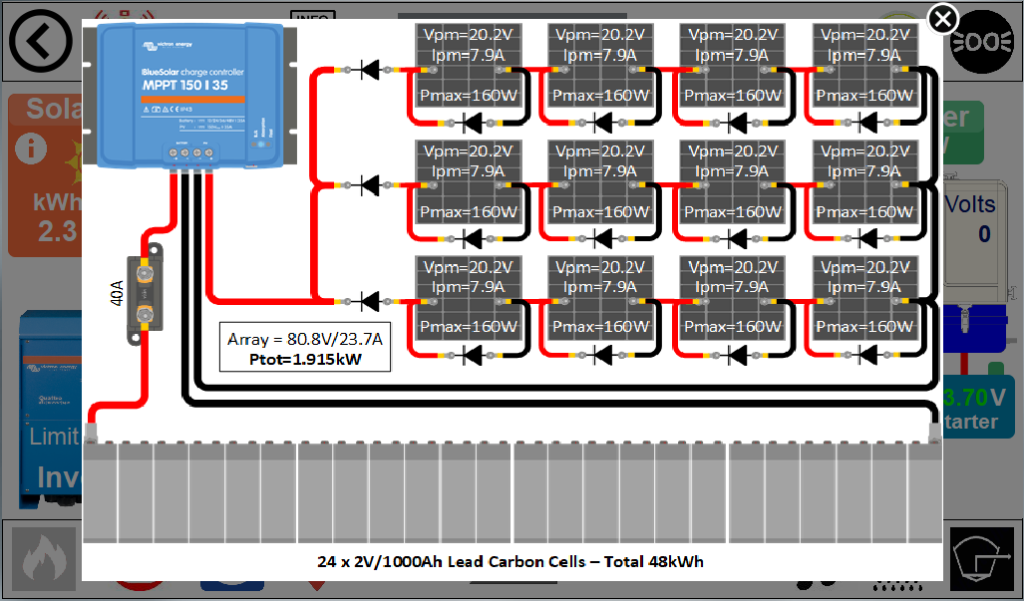
The groups of 4 panels, are joined together in parallel, so that each group can produce 8 Amps of current at 80v which gives 640 Watts of power per group. On Hunky Dory, with their three sets of panels, nearly 2000 Watts of power could be produced in the summer.
TECHNICAL NOTE – 2000W is the maximum instantaneous power that the panels create, but on any given day there will only be a certain period of time during which the sunlight is bright enough to create power and so you will see figures for solar yield (power the panels can produce) given in Watt Hours, which will usually be higher than the instantaneous power figure.
So for instance the panels on Hunky Dory could produce up to 2000W around midday, when the sun is at its strongest, but over the course of the day the average power output might only be 500W, which over a period of 12 hours of good daylight, gives a total of 6000 Watt Hours.
This is an important point and one that many people, including myself (as I was learning about solar) can find confusing.
I would dearly like to fill up the roof of “Old Nick” with a couple more panels (2 groups of 5 panels in series) and we are currently asking the manufacturer if this is possible – they quote a maximum series voltage of 100v and we will be just over this with 5 panels. Hopefully I will be able to give you an update on this very soon.
Returning to the solar system; the sun is out and the panels are outputting 80 Volts and lots of Amps, how do we then connect all of this power to the 48v batteries? Unfortunately battery charging has to be done pretty carefully and you cannot just connect all of that power directly to the battery, otherwise you will do some serious damage. You need a battery charging controller and for solar these come in two types:
- The older Pulse Width Modulation (PWM) type
- The latest Maximum Power Point Tracking (MPPT) type
The later MPPT type is so much more efficient, that most new systems have this type of controller and so for the purposes of this post, I am just going to focus on how MPPTs work.
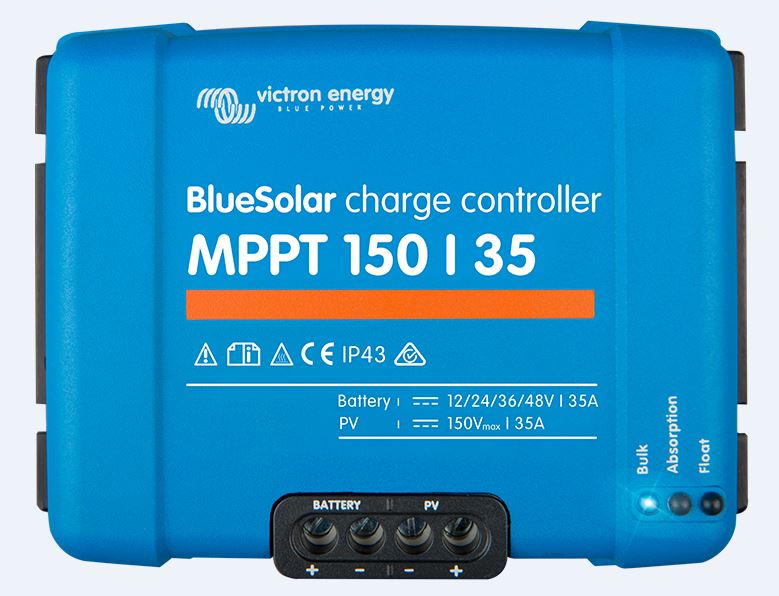
Think of the the solar panel as a source of electrical power. Those of you who remember your physics will also probably remember the mnemonic “Ivy Watts” where Current (I) multiplied by Voltage (V) = Watts. So if you have a 100 Watt solar panel, it could provide 100 Amps at 1 Volt, 1 Amp at 100 Volts, or any combination in between such as 5 Amps at 20 Volts. What decides the actual value of Amps and Voltage is the resistance (load) of the device the solar panel is connected to i.e. the MPPT controller.
What the MPPT controller does, is automatically change its resistance to get the maximum power out of the solar panel. In reality the solar panel is not linear and its own internal resistance will change with temperature, so the MPPT controller monitors (tracks) the power output of the solar panel and constantly changes its own resistance to make sure the solar panel is always at the point of maximum power output (Imp and Vmp below).
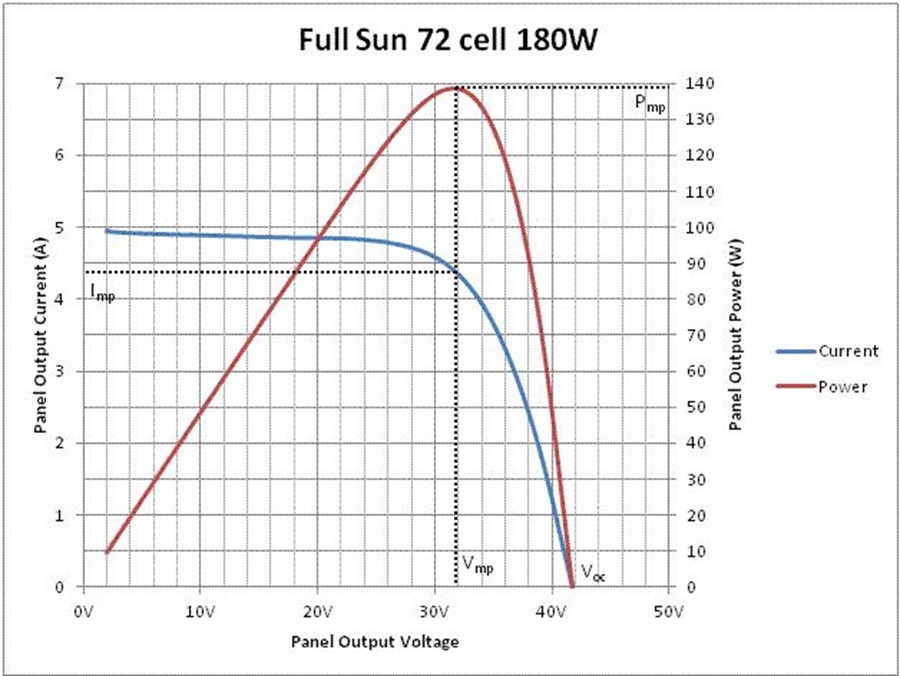
The MPPT controller also knows the best charging voltage profile for the battery and so can provide more current to the battery when it first starts charging and then taper off and provide a “float” charge as the battery becomes full again.
So a typical solar panel system is shown below. For simplicity, only one solar panel is shown but in most systems, there are more likely to be multiple panels in series and/or parallel.

Finally we come to the question that most polarises opinion on electric forums when the subject of solar panels is raised. Namely, whether to opt for a rigid panel or a semi-flexible panel.
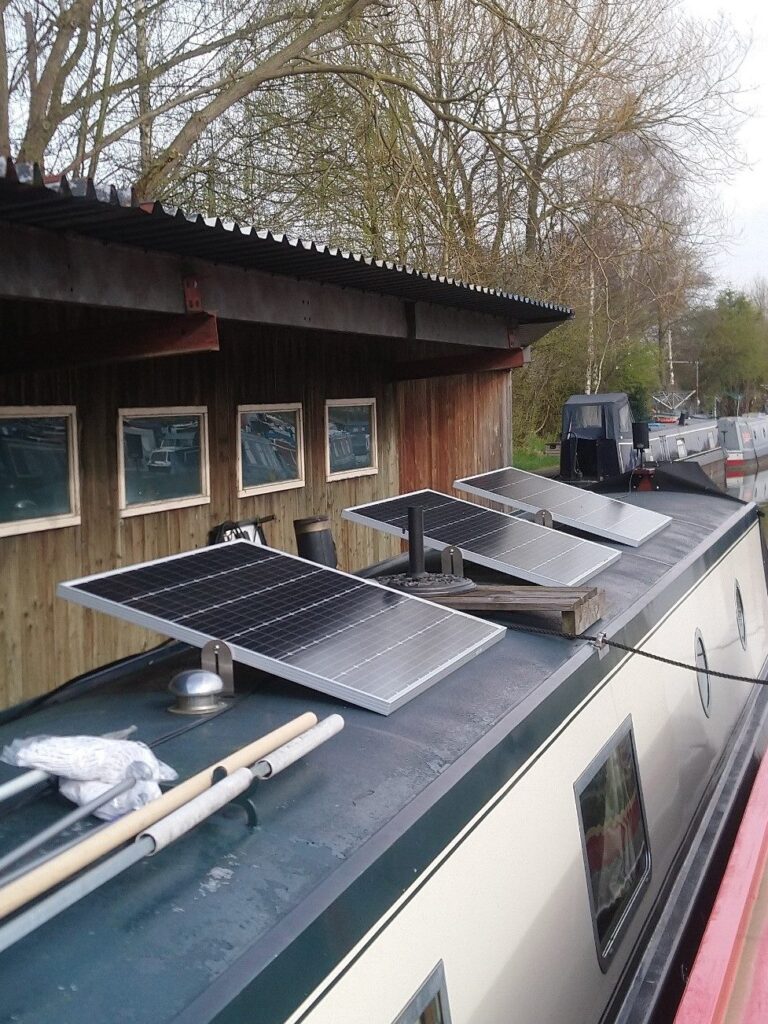
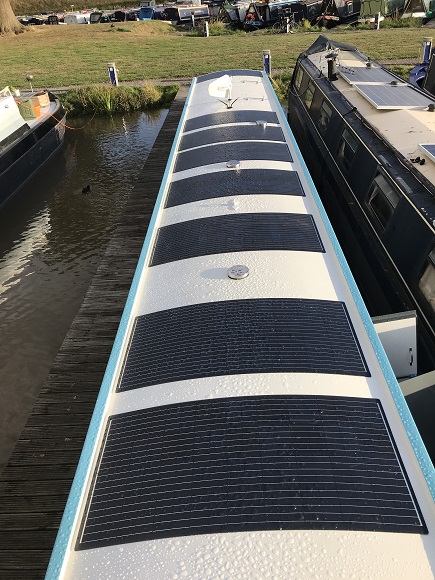
As you can see from the images above, the rigid panel on the left has a solid aluminium frame, which with the attachment of mounting brackets, allows the panel to be tilted towards the sun. The semi-flexible panels shown in the right image are very thin and can be bonded directly to the narrow boat’s roof.
So now we come to the $64000 question….do we want efficiency or aesthetics/practicality?
In terms of efficiency comparisons between the two types, it proved quite difficult to get a clear answer on this. Rigid panels have been around a lot longer and early semi-flexible panels were both less efficient and less reliable, with reports of cells cracking or developing “hot spots” on many early panels. However, technology evolves and now the latest semi-flexible panels are both more reliable and efficient.
Ortomarine have been fitting semi-flexible panels on all of their boats for the last 4-5 years and have not had a single failure, so as long as you go for a good brand and follow the manufacturer’s installation instructions, there is no reason why semi-flexible panels should not match a rigid panel in terms of efficiency and reliability.
Where rigid panels do much better than semi-flexible, is when they are mounted on brackets that allow you to angle them towards the sun. Ideally the brackets would allow the panel to be both angled and rotated to towards the sun, so that wherever the boat is moored you can position it to get maximum sunlight. However, this constant moving of the panels does require a certain level of discipline and free time and of course if they are pointing in the opposite direction when the sun rises, you will get worse solar yield than with semi-flexible panels.
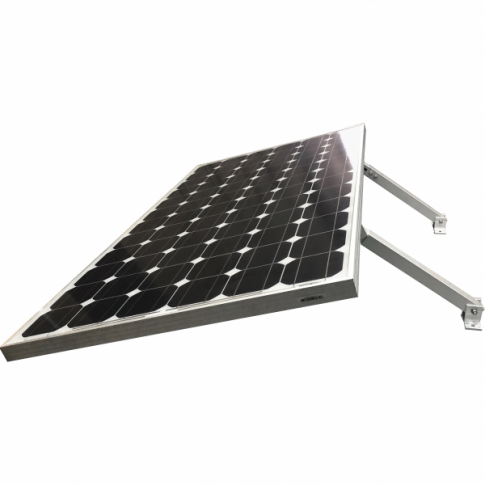
Conversely where semi-flexible panels out perform rigid panels is in every day practicality. Devoting your roof to solar panels, makes using the center rope, gaining access to the roof, etc. much more difficult but with semi-flexible you can walk on the panels (not in stilettos) and they do not get caught or snagged on ropes, trees or other objects.
After talking to Ortomarine about the reliability and looking at their historical solar yield data of the semi-flexible panels they have fitted to their boats, it was really this day to day practicality coupled with better aesthetics, that convinced me that we should fit semi-flexible panels on “Old Nick”. So now I just need to decide whether we fit 8 panels or take the slight risk and fit 10 panels.
UPDATE – Ortomarine managed to squeeze 12 panels on to the roof of “Old Nick”, by ditching the TV antenna (more on that in a future post) and moving the 3G/4G antennas, so we decided to go for it and have 12 x 160W panels giving us a potential of 1920W during the summer months!

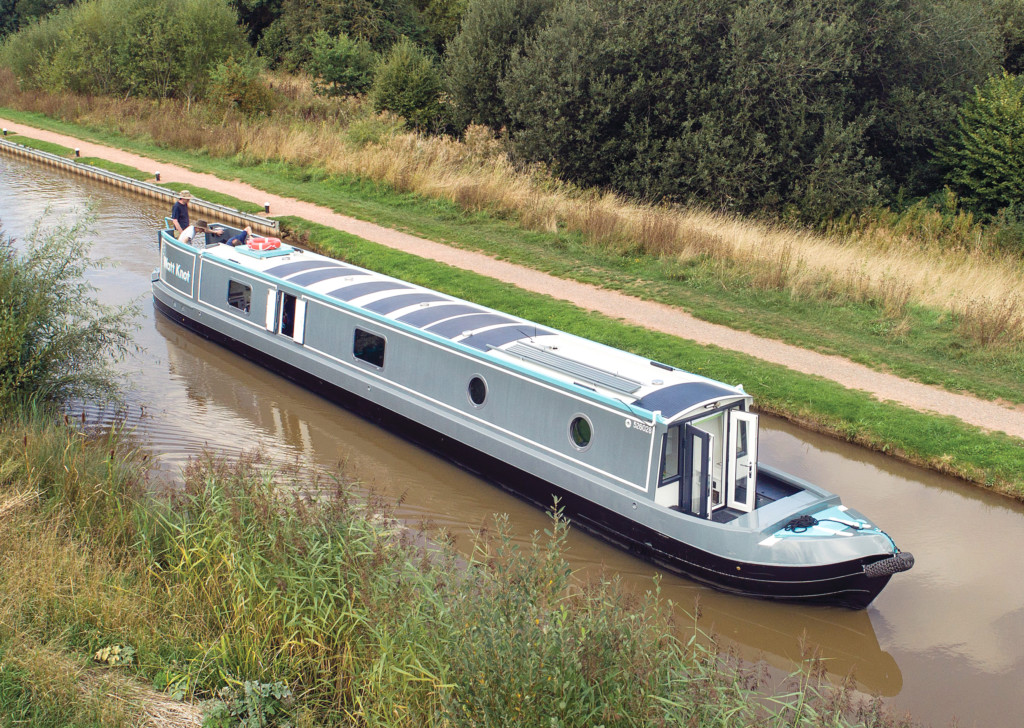
Another excellent article Paul, I really am a sucker for solar and wind power stuff.
Technical stuff. You definitely need the experts to keep you right on such a massive decision.
Luckily Paul is the guy who is rapidly developing his expertise in these interesting new fields.
Another brain work out!! Think I followed most of it, might have to re-read later! Aesthetically the semi-flexible ones are most appealing but also make ‘cruising accidents’ less likely! The MMPT sounds an amazing bit of kit – presumably that’s been through rigorous testing too? So – how to fit in those extra panels . . ?? X x
Who needs a crossword puzzle, when you can learn about solar panels 😉
Don’t worry Lynne, MPPTs have been around for quite a while now and are well proven. Also we do have enough roof space for the extra two panels, just need to decide if we can accept the slight risk of going over the panel manufacturer’s recommended 100v limit.
Enjoying this blog an very informative on the solar. More to read to get up to date so that’s the next hour taken care of!
Cheers
Ade
Thanks Ade – glad it’s of interest. Drop us a line if you have any questions.